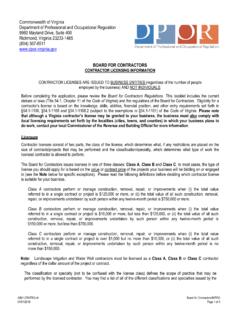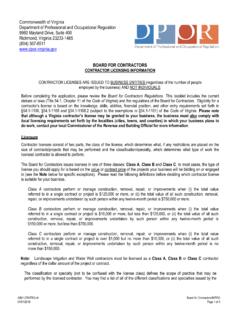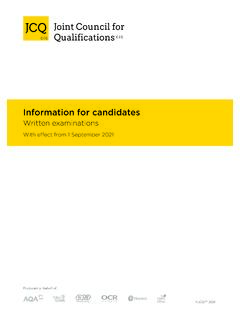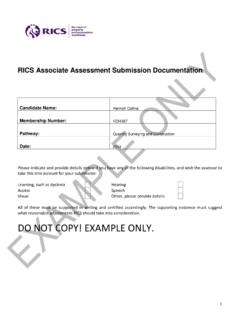Transcription of Recruitment and Selection Policy - GOV.UK
1 Recruitment and Selection Policy Issue date: 21/06/2013. Recruitment and Selection Policy 1. Purpose The purpose of this Recruitment and Selection Policy is to ensure: a professional and consistent approach to Recruitment and Selection ;. adherence to Monitor's Equality and Diversity Policy (available on Connect2) and relevant employment legislation;. that members of staff are recruited on the basis of their ability; and managers are able to attract and recruit high calibre staff. 2. Scope This Policy applies to all internal and external applicants for Monitor jobs. 3. Policy Statement We want to constantly improve our performance as an organisation. In order to make this a reality, we need to recruit from the widest possible pool of talent. Monitor aims to attract and recruit people with diverse backgrounds, skills and abilities, who will enhance the quality of service and contribute to Monitor's success.
2 Monitor is committed to providing opportunities for development and career progression to current employees. This means that Monitor will normally advertise vacancies both internally and externally. However, in exceptional circumstances and on rare occasions, there may be a strong business case for making appointments without advertising the opportunity. In order to achieve these objectives Monitor will: ensure that every director regularly reviews the organisation of their directorate and the job responsibilities and roles of individuals within it. This will be completed through the individual performance review process, when a vacancy arises, and at regular resource planning meetings;. ensure that managers consider the extent to which vacant posts could lend themselves to flexible working ( job sharing) to attract a wider range of candidates.
3 Endeavour to reach traditionally under-represented groups and ensure that discrimination does not take place at either the attraction or Selection stage;. Issue date: 21/06/2013. 1. ensure that, where a vacancy exists, posts are normally advertised externally, unless exceptional circumstances exist;. ensure that Recruitment procedures are regularly updated in line with changes in legislation and best practice;. ensure that the administration of the Selection process is user friendly and carried out to the highest professional standard. 4. Responsibilities Managers and the Recruitment and Resourcing Team are responsible for different elements of the Recruitment process. The spilt of roles and responsibilities is detailed in the Best Practice Recruitment Guide for Managers.
4 Please also see Appendix One which sets out the roles and responsibilities of Monitor's Resourcing and Recruitment Team and the role of the Manager. 5. Identification of a Recruitment Need If an established post becomes vacant or a new position of any nature is proposed, the line manager/hiring manager, should advise Human Resources (HR). Approval for Recruitment will be sought from the appropriate Executive Director and, if applicable, other governance controls will be observed before Recruitment commences. When approval has been granted, consideration should be given to whether the main accountabilities of the role could be satisfactorily met on a part-time or job-sharing basis. 6. Job Description and Person Specification A job description is a key document in the Recruitment process and must be finalised prior to taking any further steps in the process.
5 In instances of a new role or material changes to an existing role, HR will support the manager in drafting this document. Within the job description, there will be a section dedicated to the person specification, which outlines the essential and desirable criteria (including qualifications, experience, knowledge, skills and expertise required to perform the job). The detail set out in the person specification will provide the criteria against which a candidate can be assessed throughout the Recruitment process. Issue date: 21/06/2013. 2. 7. Advertising the Vacancy Internal methods Monitor may use a number of internal advertising methods such as Inside Track, HR Updates and connect 2. Where exceptional circumstances apply, the appropriate director may, in consultation with the Director of HR & CS (or with the approval of the Chief Executive where the Director of HR & CS is the appropriate director), take a decision not to advertise a role internally.
6 Every effort will be made to explain the reason for the decision to the relevant team as soon as possible after the appointment is confirmed. External methods Monitor may use a number of options to generate interest from individuals outside the organisation, including placing advertisements via Recruitment agencies, in newspapers, specialist journals, on online job boards, on Monitor's careers portal, Recruitment microsite: and LinkedIn page. As per the rules set out in the Employee Referral Programme, an incentive may also be offered to existing employees to assist in the Recruitment of their personal contacts. This programme will normally be used alongside other attraction channels in order to generate a larger pool of candidates. Irrespective of the medium used, all advertisements need to be designed and presented effectively to ensure that the widest ranges of high-calibre candidates are attracted.
7 Advertisements must be non-discriminatory and include Monitor's diversity statement. In order to provide candidates with sufficient information with which to make their decision about applying for the post, the job description will be made available on the Join Monitor website, supported by the Working at Monitor . document. 8. Applications and Shortlisting In order to facilitate a time-efficient process and minimise the burden on the majority of Monitor's highly skilled candidates who often prefer to meet with Recruitment agencies, Monitor will, where appropriate, accept the submission of a curriculum vitae as an application for a vacancy. In some instances, Monitor may ask candidates to submit further information to demonstrate their suitability for the role ( how they meet the advertised criteria in a cover letter).
8 Issue date: 21/06/2013. 3. The panel must treat applications confidentially and ensure they are assessed consistently against the criteria. The panel is also responsible for recording the reasons why candidates are shortlisted or not shortlisted. 9. Interviews and Selection Once the candidate has been successfully assessed by the Recruitment Agency (which may include a telephone interview/face-to-face interviews and/or a series of assessment tests), they will be invited to attend an interview with a panel at Monitor as a minimum requirement, and may be required to complete assessments such as case studies, presentations and/or other job-related exercises. There may also be the requirement for candidates to attend a second interview. In some instances, it may be necessary for a Monitor representative to meet candidates before a formal interview process.
9 This may be conducted at a candidate 's request in order for the individual to find out further information about Monitor. Alternatively, the meeting may be called at Monitor's request in instances where the availability of Monitor's senior managers is such that further screening needs to be undertaken before formal interview. In the latter instance, the representative will be required to make a record of the reason for or against the further progression of the candidate 's application. The panel will ensure candidates are assessed consistently against the criteria and the reasons for Selection and non- Selection must be recorded. 10. Appointing new employees HR will normally make the offer of appointment to the preferred candidate (s). either directly or via the Recruitment agency.
10 Upon acceptance, HR will liaise with candidates and confirm the appointment once the formalities have been completed ( satisfactory references from last two employers, work health assessment, confirmation of educational and/or qualification, and confirmation of right to work in UK). These requirements should be completed before the new employee takes up post. HR must approve any exceptions in advance of formal appointment. 11. Equal Opportunities Discrimination Throughout the whole Recruitment process, it is vital to avoid discrimination as this can give rise to a claim for unlimited damages before an employment tribunal. Under employment law an employer must not discriminate on the protected characteristics of age, gender, gender reassignment, pregnancy, marital status or civil partnership, race, colour, Issue date: 21/06/2013.
















